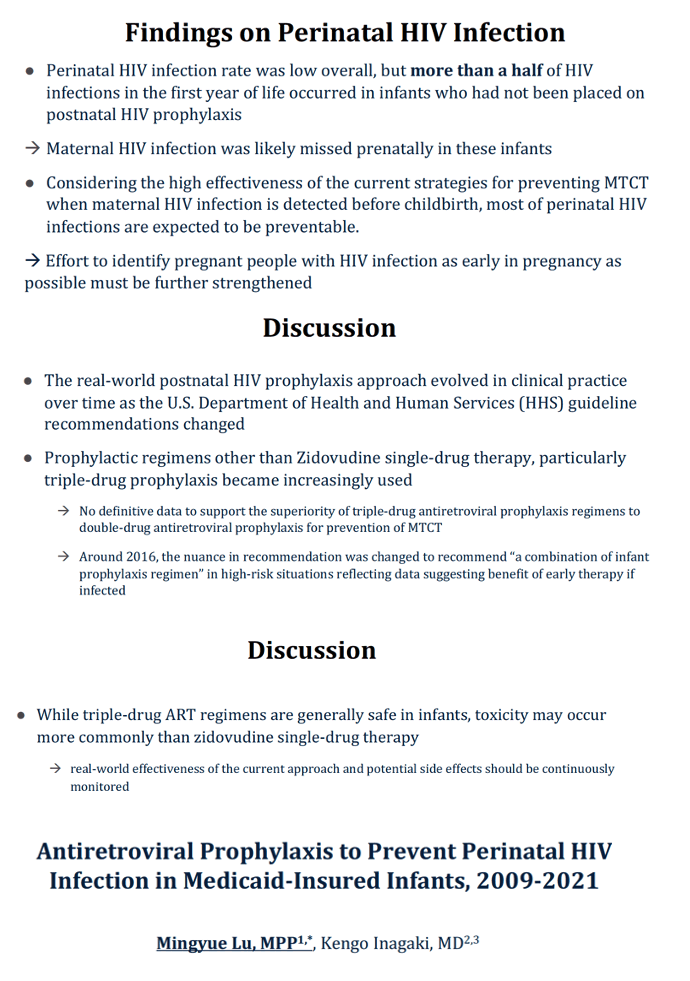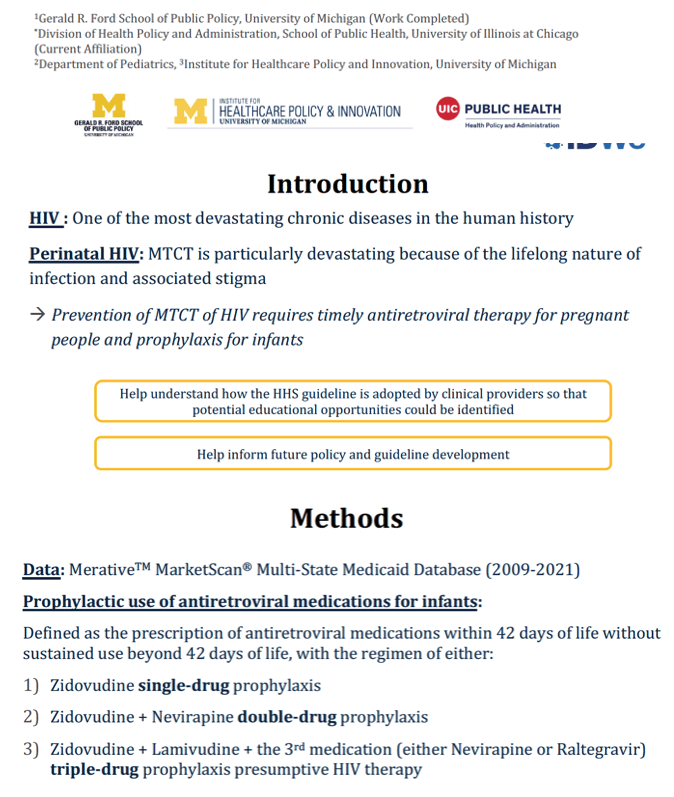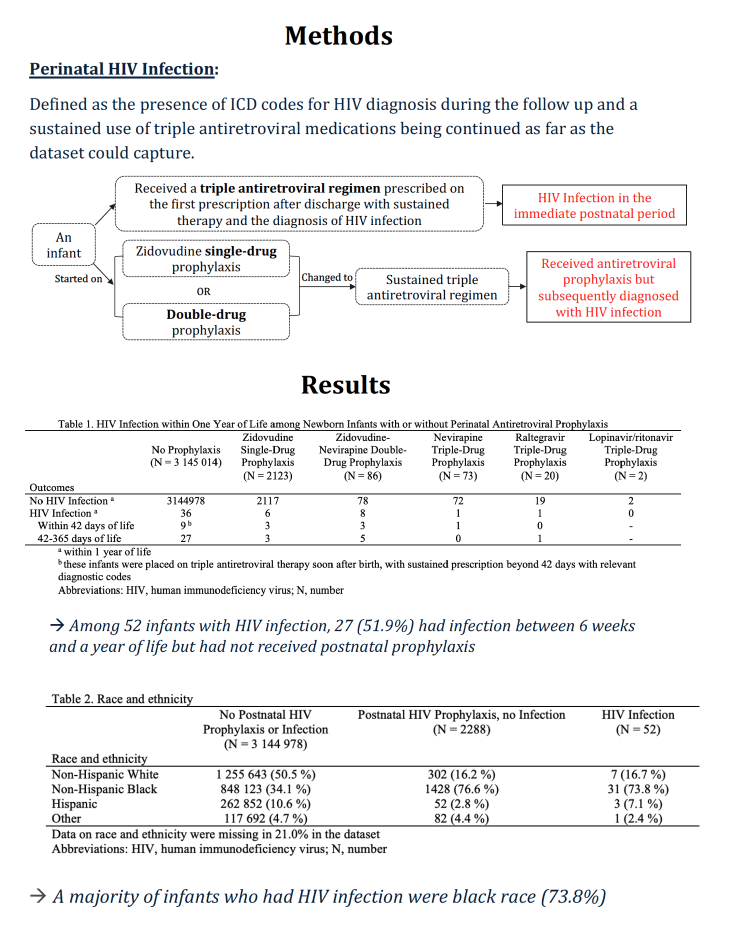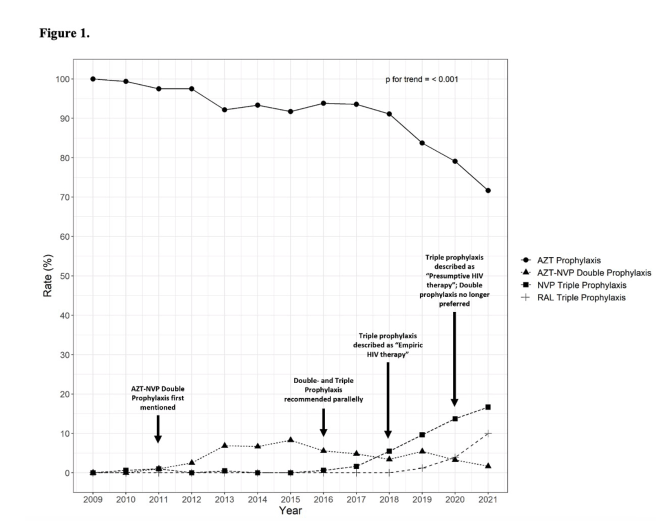 |
 |
 |
| |
Antiretroviral prophylaxis to prevent perinatal HIV infection in Medicaid-insured infants, 2009-2021: Over Half of HIV Infections in First Year of Life Reflect No Postnatal HIV Prophylaxis...majority Black Race
|
| |
| |
IDWeek, October 16-19, 2024, Los Angeles
Mark Mascolini
Among 52 Medicaid-insured infants who acquired HIV infection in the first year of life, 27 of them (51.9%) had HIV between 6 weeks and 1 year but had not received postnatal prophylaxis against HIV [1], Lack of postnatal prophylaxis probably means these 27 women never got tested for HIV. Data from the Merative MarketScan Multi-State Medicaid Database for 2009-2021 also showed that numbers of US infants who acquire HIV infection in the first year of life have plummeted since the days of zidovudine monotherapy prophylaxis.
Mingyue Lu (currently at the University of Illinois at Chicago) and Kengo Inagaki (University of Michigan) conducted this study to explore how US providers adopt Health and Human Services guidelines over time, aiming to discover educational opportunities involving mother-to-child transmission of HIV. They based their analysis of prophylactic antiretrovirals for infants on de-identified patient-level data stored in the Merative MarketScan Multi-State Medicaid Database [2]. (Medicaid is a US federal and state program that provides health coverage to eligible low-income individuals and families.)
Lu and Inagaki defined antiretroviral prophylaxis in infants as prescription of one or more antiretrovirals within 42 days of life without sustained use beyond 42 days of life. They considered three types of antiretroviral prophylaxis: (1) zidovudine single-drug prophylaxis, (2) zidovudine plus nevirapine (NVP) double-drug prophylaxis, and (3) zidovudine plus lamivudine plus a third drug, either NVP or raltegravir, to create triple-drug prophylaxisand presumptive HIV therapy.
The two collaborators defined perinatal HIV infection as "ICD codes for HIV diagnosis during follow-up and sustained use of triple antiretroviral medications" continued for as long as data on that infant accrued. They specified that infants receiving single- or double-drug prophylaxis subsequently got diagnosed with HIV and switched to triple antiretroviral therapy. The triple-drug prophylaxis group consisted of Infants who initially got triple therapy prescribed as their first regimen and continued that therapy with their HIV diagnosis. Triple-antiretroviral infants had HIV infection in the immediate postnatal period.
The heft of clinical databases like MarketScan becomes obvious in the number of infants identified with no prophylaxis (3,145,014) and infants with no prophylaxis plus no HIV infection (3,144,978). Most infants in this database who got HIV in the first year of life, 36 of 52 (69.2%), fell into the no-prophylaxis group. HIV in the first year of life HIV got diagnosed in 6 of 2123 infants (0.28%) receiving single-drug prophylaxis, 8 of 86 (9.3%) getting double-drug prophylaxis, 1 of 73 (1.37%) on NVP triple-drug prophylaxis, 1 of 20 (5%) on raltegravir triple-drug prophylaxis, and 0 of 2 on lopinavir/ritonavir triple-drug prophylaxis. Of course these HIV rates cannot be compared from one regimen to the next because of the countless variables that differ between groups and because the number of infants in each group falls steeply over time.
What is striking about the 52 infants diagnosed with HIV in their first year of life is that 27 of them (51.9%) acquired HIV between 6 weeks and 1 year of life but never got postnatal HIV prophylaxis. Lu and Inagaki proposed that clinicians cleanly missed prenatal maternal HIV infection in the 27 mothers-an oversight stunning in its high prevalence.
Of the 52 infants diagnosed with HIV in the first year of life, 31 (73.8%) were non-Hispanic black, 7 (16.7%) non-Hispanic white, 3 (7.1%) Hispanic, and 1 (2.4%) another race or ethnicity. Proportions with postnatal HIV prophylaxis and no HIV infection in the first year of life were 76.6% in non-Hispanic blacks, 16.2% in non-Hispanic whites, 2.8% in Hispanics, and 4.4% in others.
HIV prophylaxis rate per 100,000 births fell from about 93 in 2009 to about 60 in 2021 (P for trend 0.19), and that decline tracked loosely with infant HIV infections per 1 million births-about 3 in 2009 to about 1 in 2021 (P for trend 0.062).
The researchers observed that use of more complicated antiretroviral combinations for postnatal prophylaxis evolved in a manner reflecting US Health and Human Services guidelines, culminating in use of three-drug prophylactic combinations. But Lu and Inagaki stressed that no definitive data support use of triple-drug postnatal prophylaxis over double-drug prophylaxis. They noted that a nuance in these guidelines emerged around 2016 favoring "a combination infant prophylaxis regimen" in infants with a high risk of HIV acquisition because early combination therapy would have benefits in infants who did become infected. But the researchers added that, although triple combinations are usually safe in infants, toxicity may prove more frequent than with simpler prophylactic strategies. "Real-world effectiveness" of current favored prophylactic combinations," Lu and Inagaki added, "should be continuously monitored" for side effects.
References
1. Lu M, Inagaki K. Antiretroviral prophylaxis to prevent perinatal HIV infection in Medicaid-insured infants, 2009-2021. IDWeek, October 16-19, 2024, Los Angeles. Abstract 392.
2. MarketScan. MarketScan Research Databases for life sciences researchers. https://www.merative.com/content/dam/merative/documents/brief/marketscan-research-databases-for-life-sciences-researchers.pdf





|
| |
|
 |
 |
|
|